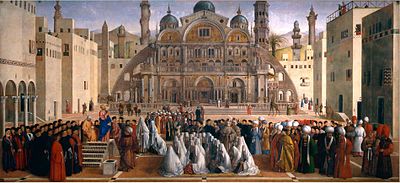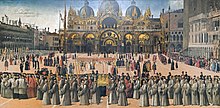Gentile Bellini
He came from Venice's leading family of painters, and, at least in the early part of his career, was more highly regarded than his younger brother Giovanni Bellini - a reversal of the situation today.
In addition to his portraits, he painted a number of very large works with multitudes of figures, especially for the Scuole Grandi of Venice, wealthy confraternities that were very important in Venetian patrician social life.
Although today Gentile is often seen in the shadow of his more famous family members, in his own time he was considered among the greatest living painters in Venice and had no shortage of commissions; his talent as a portraitist revealed itself at an early age.
Much of Gentile Bellini's surviving work consists of very large paintings for public buildings, including those for the Scuola Grande di San Giovanni Evangelista.
Along with Lazzaro Bastiani, Vittore Carpaccio, Giovanni Mansueti, and Benedetto Rusconi, Bellini was one of the artists hired to paint the 10-painting narrative cycle known as The Miracles of the Relic of the Cross.
Venice was, at that time, a very important point in which cultures and trade bordered on the eastern Mediterranean Sea and provided gateways to Asia and Africa.
Gentile, fearful at such barbarities, immediately tried in every way to be released from his contract in case one day he himself should be the victim of such a joke.This anecdote is likely apocryphal, as a similar story had been told by Seneca of Parrhasius, as well as of Michelangelo via a dubious source.
[8] Gentile responded to other aspects of the East, including the Byzantine Greek Empire,[5] as well as Venice's other trading partners in North Africa and Levant.
Only a few of his other works remain, namely the large narrative paintings The Procession in Piazza San Marco (above left) and The Preaching of Saint Mark in Alexandria (above right), produced in his final years.






